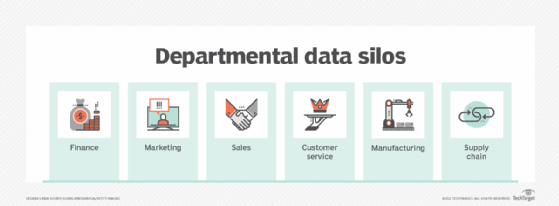
Getty Images/iStockphoto
4 information governance challenges and how to overcome them
Organizations often neglect information governance in favor of more revenue-generating initiatives. This leads to challenges with information growth and fragmented systems.
Until a compliance crisis happens, people typically overlook information governance.
This happens because organizations tend to prioritize processes and technologies that directly lead to increased revenue. Information governance (IG), on the other hand, can reduce security risks and lead to indirect gains in revenue -- a much less attractive investment to many C-level executives.
This underinvestment in IG, compared to other areas, leads to challenges in the following areas:
- Information growth.
- Information islands.
- Perception of IG as an expensive add-on.
- Employee resistance.
To implement an effective IG program, organizations must understand these challenges and how they continue to evolve.
1. Information growth
The most overwhelming IG challenge is the exponential growth of information. As new types of digital information -- videos, IoT data and social media posts -- emerge each year, organizations can struggle to manage it all.
Much information growth within organizations is due to larger file sizes. For instance, video recordings of meetings use a lot more storage than meeting notes, yet the same business requirements govern them. This changes the nature of the problem but not the scope or effort required to resolve it.
Additionally, volume increases don't always mean a large increase in the types of information to govern. For example, if chat conversations double, the challenges regarding preservation and classification do not double in complexity.
Still, new formats of information require new methods for searching compliant data. Additionally, higher volumes of information increase the risk of improper management over time. This continued growth increases urgency for organizations to properly meet IG requirements to keep information secure and accessible to the right parties.
2. Information islands
In the early 2000s, organizations struggled with information or data siloes, which happens when information is confined within specific departments or systems. Now, modern organizations connect their information repositories to the wider enterprise, so different teams can access the same data. This advancement stemmed from digital transformation efforts to remove siloes and adopt systems that more easily connect with APIs.
Still, organizations suffer from information islands, which are data sources that operate separately from one another despite being connected in some way. For example, if project information resides in one team's software that connects to another team's systems, those teams might still struggle to get a complete picture or manage all the information as a single collection.
To overcome this challenge, information professionals can first map all information islands and their respective connections to determine where their information resides. Ideally, they can then implement an IG interface and tool to manage all the data. However, many organizations -- particularly SMBs -- lack the capacity to deploy these tools. Instead, they can implement checklists and processes to fill the gaps and manage projects and information.

3. Perception of IG as an expensive add-on
Information governance and other risk-mitigating practices often suffer when compared to more revenue-driving features. Until a crisis occurs, executives typically do not want to invest in IG. For example, after the 2001 Enron scandal, many organizations invested in IG software to meet the Sarbanes-Oxley Act compliance regulations. Yet once they achieved compliance, most businesses stopped spending money on it.
When the IG team walks into the room, modern executives see increased project costs with no gain, much like how they once viewed security requirements. When security breaches became more frequent, organizations more willingly invested in cybersecurity to avoid problems. A similar shift in perspective might occur in IG as more organizations experience compliance failures.
To win executive support, IG professionals must convey the benefits of proper IG. Reduced search times, errors and duplicate work all add value to the business, as they lower costs and increase productivity. Information professionals can apply metrics, such as the average time employees spend searching for information, to quantify those benefits.
4. Employee resistance
Most employees, whether salespeople, developers or program managers, do not want records management responsibilities because they do not view them as part of their job descriptions. While employees must store information in the proper location and identify it correctly, applying governance rules should not be the average employee's responsibility.
Before electronic repositories, organizations often made multiple copies of important forms. The average employee knew to send one copy to the records office, which only required them to put a yellow copy in a labeled records outbox. The process was simple and did not require any special training.
Since then, electronic records management systems introduced features that let employees declare records or classify documents based on their content. This approach requires employees to actively understand the types of records, such as financial or employee records, each of which have their own retention schedules for how long organizations should keep them. If retention rules change, organizations must retrain employees.
To overcome this challenge, organizations can automate IG processes such as information identification and categorization. As these capabilities handle governance automatically, employees only need to learn where to place information.
How to overcome information governance challenges
Organizations can address these common information governance challenges if they map their current information ecosystems and engage both IT and business leaders. Open, constructive conversations between these teams can lead to IG progress.
Information professionals cannot implement IG overnight. It requires them to prioritize long-term goals over quick fixes and collaborate with different departments across their organizations.
Laurence Hart is director of consulting services at CGI Federal and has more than 20 years of IT experience.







